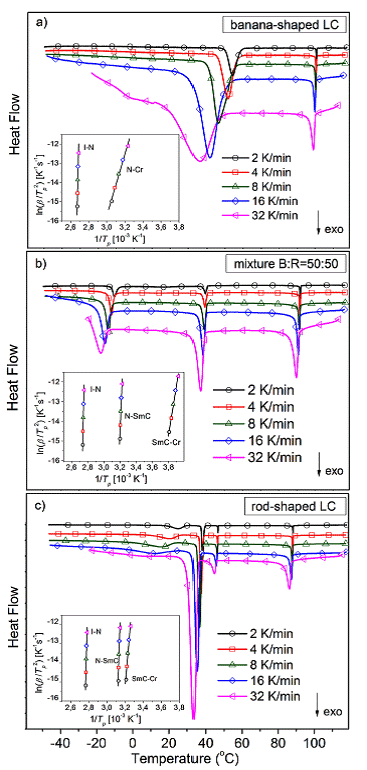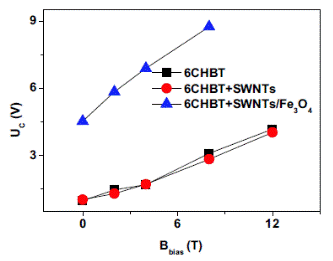Ferronematics are suspensions of magnetic nanoparticles (e.g. magnetite, carbon nanotubes functionalized by ferromagnetic particles) in nematic liquid crystals prepared in an effort to increase the sensitivity of liquid crystals to magnetic field. The electro- and magneto-optical behaviour of these substances is studied in co-operation with the Institute of Experimental Physics, Koice, Slovakia.
Participating
researchers: Nándor
Éber, Katalin Fodor-Csorba, Péter Salamon, Tibor Tóth-Katona and Anikó Vajda
Recent
results
The influence of magnetic field
on the isotropic-to-nematic phase transition temperature is investigated in
neat bent-core and calamitic liquid crystals, in their mixture, and in samples
doped with spherical magnetic nanoparticles for two different orientations of
the magnetic field. A magnetic-field-induced negative or positive shift of the
transition temperature was detected depending on the magnetic field orientation
with respect to the initial orientation of the nematic phase, and on the type
of liquid crystal matrix.


T. Tóth-Katona, V. Gdovinová, N.
Tomaovičová, N. Éber, K.
Fodor-Csorba, A. Juríková, V. Záviová, M. Timko, X. Chaud, and P.
Kopčanský, Tuning the phase
transition temperature of ferronematics with magnetic field,. Soft
Matter 14, 1647-1658 (2018).
[pdf]
We report on experimental
studies focusing on the dynamic ac magnetic susceptibility of a ferronematic.
It has been shown recently, that in the isotropic phase of a ferronematic, a
weak dc bias magnetic field of a few oersteds increases the ac magnetic susceptibility.
This increment vanishes irreversibly if the substance is cooled down to the
nematic phase, but can be reinduced by applying the dc bias field again in the
isotropic phase [Tomaovičová, N. et al. Soft Matter 2016, 12, 57805786].
The effect has no analogue in the neat host liquid
crystal. Here, we demonstrate that by doubling the concentration of the
magnetic nanoparticles, the range of the dc bias magnetic field to which the
ferronematic is sensitive without saturation can be increased by about two
orders of magnitude. This finding paves a way to application possibilities,
such as low magnetic field sensors, or basic logical elements for information
storage.

N. Tomaovičová, J. Kováč, V.
Gdovinová, N. Éber, T. Tóth-Katona,
J. Jadżyn and P. Kopčanský: Alternating
current magnetic susceptibility of a ferronematic, Beilstein J. Nanotechnol. 8, 2515-2520 (2017). [pdf]
This
work is devoted to the study of composite systems of the liquid crystal 4-n-hexyl-4-cyanobiphenyl
(6CB) doped with differently shaped magnetite nanoparticles. The ferronematic
samples were prepared with the volume concentration of f =105 of spherical, as
well as of rod-like magnetic particles. The structural transitions in ferronematic
samples were observed by capacitance measurements in a capacitor made of indium-tin-oxide-coated
glass electrodes in combined electric and magnetic fields.


V. Gdovinová, N.
Tomaovičová, N. Éber,
P. Salamon, T. Tóth-Katona, V. Záviová, J. Kováč, J. Jadzyn and P.
Kopčanský: Ferronematics based on
the nematic 6CB in combined electric and magnetic fields, Phase
Transitions 90, 790-799 (2017). [pdf]
A binary mixture of bent-core and rod-shaped liquid crystals was chosen as a model substance combining the properties of both types of liquid crystals. The mixture was doped with a small amount of spherical and rod-like magnetic nanoparticles. Differential scanning calorimetry experiments were performed for the pure as well as for the doped mixture at different heating rates ranging from 1 to 16 C/min. The addition of the magnetic nanoparticles lowered the phase transition temperature. This effect is more intensive in the case of the rod-like magnetic nanoparticles. The kinetics of the nematic to isotropic phase transition was evaluated in the framework of the differential isoconversional method. The calculated apparent activation energy showed non-monotonic behaviour and a sensitivity on the shape of added magnetic nanoparticles.


K.
Csach, A. Juríková, J. Mikuf, N. Tomaovičová, V. Gdovinová, V. Záviová,
P. Kopčanský, N. Éber, K. Fodor-Csorba, A.
Vajda: Kinetics of Nematic to Isotropic Phase
Transition in Liquid Crystal Doped with Magnetic Nanoparticles, Acta Physica Polonica 131,
949-951 (2017). [pdf]
 In this work the
4-n-hexyl-40-cyanobiphenyl liquid crystal was doped with differently shaped
magnetite nanoparticles. The structural changes were observed by capacitance
measurements. Influence of the shape of magnetic particles on magnetic
Fréedericksz transition depends on the type of anchoring, which is
characterized by the density of the anchoring energy and by the initial
orientation between the liquid crystal molecules and the magnetic moment of the
magnetic particles. It was observed that in the case of doping with spherical
particles, the critical magnetic field is shifted to higher values with
increase of volume concentration of the magnetic nanoparticles but decreases
with increase of biasing voltage. In the case of doping with rod-like
particles, the critical magnetic field is almost independent of the volume concentration
of the magnetic nanoparticles.
In this work the
4-n-hexyl-40-cyanobiphenyl liquid crystal was doped with differently shaped
magnetite nanoparticles. The structural changes were observed by capacitance
measurements. Influence of the shape of magnetic particles on magnetic
Fréedericksz transition depends on the type of anchoring, which is
characterized by the density of the anchoring energy and by the initial
orientation between the liquid crystal molecules and the magnetic moment of the
magnetic particles. It was observed that in the case of doping with spherical
particles, the critical magnetic field is shifted to higher values with
increase of volume concentration of the magnetic nanoparticles but decreases
with increase of biasing voltage. In the case of doping with rod-like
particles, the critical magnetic field is almost independent of the volume concentration
of the magnetic nanoparticles.
V. Gdovinová, N.
Tomaovičová, V. Záviová, N.
Éber, T. Tóth-Katona, F. Royer, D. Jamon, I. Vávra, J. Jadzyn, and P.
Kopčanský: Low Magnetic Field
Response in Ferronematics, Acta Physica Polonica 131,
934-936 (2017). [pdf]
The magnetic properties of a ferronematic, i.e., a nematic liquid crystal doped with magnetic nanoparticles in low volume concentration are studied, with the focus on the ac magnetic susceptibility. A weak dc bias magnetic field (a few Oe) applied to the ferronematic in its isotropic phase increases the ac magnetic susceptibility considerably. Passage of the isotropic-to-nematic phase transition resets this enhancement irreversibly (unless the dc bias field is applied again in the isotropic phase). For explanation a model is proposed based on aggregation of nanoparticles at the isotropic-nematic phase transition and on their disaggregation under magnetic field in the isotropic phase.


N. Tomaovičová, J. Kováč, Y. Raikher, N. Éber, T. Tóth-Katona, V.
Gdovinová, J. Jadzyn, R. Pinčák, and P. Kopčanský: Biasing a ferronematic a new way to detect weak magnetic field. Soft Matter 12, 5780-5786 (2016).
[pdf]
We have investigated the influence of doping with
spherical magnetic nanoparticles on the mixture of a bent-core and a calamitic
liquid crystal. Results showed a reduction of the critical field of the
magnetic Fréedericksz transition by more than a factor of two after the doping.
Moreover, we give for the first time experimental evidence of the theoretically
predicted magnetically induced negative shift of the isotropic to nematic phase
transition temperature.
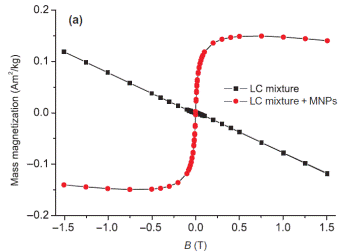
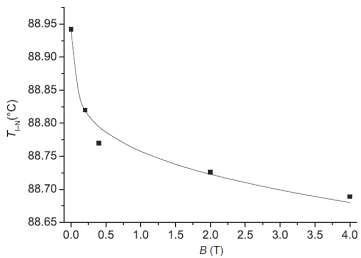
N. Tomaovičová,
M. Timko, N. Éber, T. Tóth-Katona, K. Fodor-Csorba, A. Vajda, V. Gdovinová, X. Chaud,
and P. Kopčanský: Magnetically Induced Shift of
the Isotropic-Nematic Phase Transition Temperature in a Mixture of Bent-Core
and Calamitic Liquid Crystals Doped with Magnetic Particles, Liquid Crystals,
42,
959-963 (2015) [[pdf]
|
In the work phase transitions in bent-core liquid
crystals were studied using differential scanning calorimetry. For the binary
mixture of bent-core molecules with 50 wt% of rod-shaped compound, the
nematic to smectic transition occured below 40oC and the
crystallization temperature shifted to sub-ambient temperatures. The
influence of doping of the bent-core liquid crystals with magnetic
nanoparticles on the kinetics of observed phase transitions was studied. The
phase transition temperatures were shifted depending on the nanoparticle type
and changed with varying cooling rate for all studied liquid crystal samples. |
|
A. Juríková, K. Csach, J. Mikuf,
N. Tomaovičová, Z. Mitróová, V. Záviová, M. Koneracká, P.
Kopčanský, M. Timko, N. Éber, K. Fodor-Csorba, A. Vajda: Thermal Stability
of Bent-Core Liquid Crystals Doped with Magnetic Nanoparticles, Acta Phys. Polon. A 127(2), 638-640 (2015) [pdf]
Liquid crystals, due to their large dielectric anisotropy,
respond very sensitively to application of an external electric field, whereas
they are only weakly sensitive to the magnetic field. A possible way of
improving that sensitivity is doping liquid crystals with magnetic
nanoparticles. As a result, stable colloidal suspensions of liquid crystals
with relatively low concentrations of magnetic nanoparticles (called
ferronematics, ferrocholesterics, ferrosmectics, etc.) can be produced. We
illustrate some examples of the influence of the magnetic field, as well as of
a superposition of magnetic and electric fields on the structural transitions
(e.g. on the Fréedericksz transition) in ferronematics based on the calamitic
liquid crystal 4-(trans-4'-n-hexylcyclohexyl)-isothiocyanatobenzene (6CHBT). It
is shown that the samples respond to the applied magnetic field of low
strength. The effects of the magnetic particles and magnetic field on the
nematic to isotropic phase transition temperature are discussed as well.

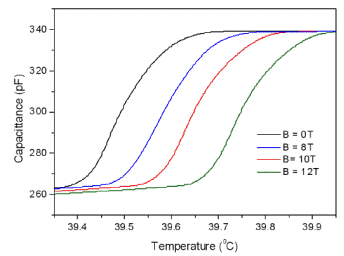
P. Kopčanský, N. Tomaovičová,
V. Gdovinová, M. Timko, N. Éber, T. Tóth-Katona, J. Jadzyn, J. Honkonen and X.
Chaud: How to Enhance Sensitivity of Liquid
Crystals to External Magnetic Field?, Acta Phys. Polon. A 127(2), 157-162 (2015) [pdf]
The influence of the shape anisotropy of magnetic
particles on the isotropicnematic phase transition was studied in
ferronematics based on the nematic liquid crystal (LC)
4-(trans-4-n-hexylcyclohexyl)-isothiocyanato-benzene (6CHBT). The LC was doped
with spherical or rod-like magnetic particles of different size and volume
concentrations. The phase transition from isotropic to nematic phase was
observed by polarising microscope as well as by capacitance measurements. The
influence of the concentration and the shape anisotropy of the magnetic
particles on the isotropicnematic phase transition in LC are demonstrated
here. The results are in a good agreement with recent theoretical predictions.

V. Gdovinová, N.
Tomaovičová, N. Éber, T. Tóth-Katona, V. Záviová, M. Timko and P.
Kopčanský: Influence of the anisometry of magnetic particles on the
isotropicnematic phase transition, Liquid Crystals 41(12), 1773-1777
(2014) [pdf]
The contribution is an
overview of the observations regarding the structural transitions in
ferronematics based on thermotropic nematics doped with magnetic nanoparticles
of different shape, and the magnetic field induced shift of the isotropic to
nematic phase transition temperature. Due to presence of magnetic particles an
increase of the isotropic-nematic phase transition temperature was observed as
a function of applied magnetic field. The response of ferronematics to very low
magnetic fields is also presented which is important for the construction of various
magneto-optical devices.
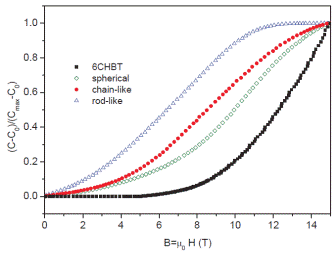
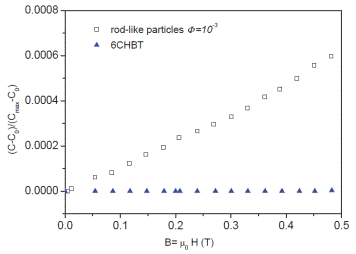
P. Kopčanský, N. Tomaovičová, M. Timko, V. Gdovinová, T. Tóthkatona, N. Éber,
C.-K. Hu, S. Hayryan, X. Chaud: F.1.17.
- Increase of the sensitivity of liquid crystals to magnetic field due
to doping with magnetic nanoparticles. In. Proceedings of the 9th International Conference on Fundamental
and applied MHD, Thermo acoustic and Space technologies,Riga, June 16-20, 2014, pp. 337-341 [pdf]
We investigated experimentally the
magneto-optical and dielectric properties of magnetic-nanoparticle-doped
nematic liquid crystals (ferronematics). Our studies focus on the effect of the
very small orienting bias magnetic field Bbias,
and that of the nematic director pretilt at the boundary surfaces in our
systems sensitive to low magnetic fields. Based on the results we assert that Bbias is not necessarily
required for a detectable response to low magnetic fields, and that the initial
pretilt, as well as the aggregation of the nanoparticles play an important
(though not yet explored enough) role.


T. Tóth-Katona, P. Salamon, N. Éber, N. Tomaoviċová, Z. Mitróová, and P. Kopċanský: High concentration ferronematics in low magnetic fields, J. Magn.
Magn. Mat., 372, 117-121 (2014) [pdf]
N. Tomaoviċová, M. Timko, V.
Záviová, M.
Koneracká, Z. Mitróová, A. Hashim, M. Rajňák, N.
Éber, T. Tóth-Katona, K. Fodor-Csorba, A. Vajda, P. Kopċanský:
Ferronematics: Combinations of Liquid Crystals with Magnetic Fluids, In Eds. M. Reiffers, P. Rybár, .
Molokáč, Transformation of Knowledge
and Technologies to the Praxis Obtained by Research and Development in the
Earth Resources Area. Slovak Physical Society, 2013, pp. 65-73 [pdf]
|
Magnetic Fréedericksz transition was studied in
ferronematics based on the nematic liquid crystal
4-(trans-4-n-hexylcyclohexyl)-isothiocyanatobenzene (6CHBT). 6CHBT was doped
with rod-like magnetic particles of different size and volume concentration.
The volume concentrations of magnetic particles in the prepared ferronematics
were φ1=10−4 and φ2=10−3.
Structural changes were observed by capacitance measurements, which evidenced
of a significant influence of the concentration, shape anisotropy and/or the
size of the magnetic particles on the magnetic response of these
ferronematics. |
|
P. Kopċanský, N. Tomaoviċová, T. Tóth-Katona, N.
Éber, M. Timko, V. Záviová, J. Majoroová, M. Rajňak, J. Jadzyn, X.
Chaud: Increasing the magnetic
sensitivity of liquid crystals by rod-like magnetic nanoparticles, Magnetohydrodynamics
49(3-4), 586-591 (2013) [pdf]
The response in capacitance to low external magnetic
fields (up to 0.1 T) of suspensions of spherical magnetic nanoparticles, single-wall
carbon nanotubes (SWCNT), SWCNT functionalized with carboxyl group (SWCNTCOOH),
and SWCNT functionalized with Fe3O4 nanoparticles in a
nematic liquid crystal has been studied experimentally. The volume
concentration of nanoparticles was φ1 = 10−4 and φ2 = 10−3.
Independent of the type and the volume concentration of the nanoparticles, a
linear response to low magnetic fields (far below the magnetic Fréederiksz
transition threshold) has been observed, which is not present in the undoped
nematic.
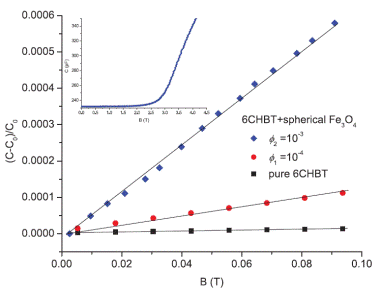
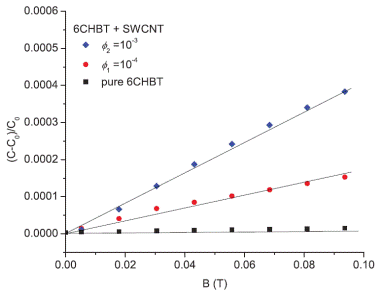
N. Tomaovičová, M. Timko, Z. Mitróová, M. Koneracká, M. Rajňak,
N. Éber, T. Tóth-Katona, X. Chaud, J. Jadzyn, and P. Kopčanský:
Capacitance changes in ferronematic liquid crystals induced by low magnetic
fields. Phys. Rev. E
87, 014501/1-4 (2013) [pdf]
In the present chapter we introduce the basic
field-induced reorientational effect of liquid crystals (the Fréedericksz
transition) which serves also as a basis for most experiments on ferronematics.
We will sketch the mechanism how magnetic particles may affect the magnetic
response. We will describe the preparation of magnetic particles and of the
ferronematics made of them.
An overview is given of the experimental results
obtained on the behaviour of ferronematics depending on the host liquid
crystal, on the type, shape, size and concentration of the magnetic particles.
A special emphasis is given to the magnetic field
induced shift of the isotropic-nematic phase transition temperature, both in
ferronematics and in polymer dispersed liquid crystals doped with magnetic
particles.


N. Tomaovičová, P. Kopčanský, N. Éber: Chapter 11, Magnetically Active Anisotropic Fluids Based on Liquid Crystals, In Ed. H.G. Lemu, Anisotropy
Research: New Developments, Nova Science Publishers, 2012, pp. 253-282
The thermotropic liquid crystal
4-(trans-4-n-hexylcyclohexyl)-isothiocyanato-benzene (6CHBT) has been doped
with magnetic
nanoparticles of different shapes. An increase of the
isotropic-to-nematic phase transition temperature was observed in the liquid
crystal doped with rodlike particles at high magnetic fields. To our knowledge,
this is the first observation of a magnetic field induced shift of the phase
transition in ferronematics based on a calamitic
liquid crystal.

P. Kopčanský, N. Tomaovičová, M. Koneracká,
V. Záviová, M. Timko, M. Hnatič, N. Éber, T. Tóth-Katona, J. Jadzyn,
J. Honkonen, E. Beaugnon, X. Chaud, Magnetic-field induced isotropic to
nematic phase transition in ferronematics. IEEE T. Magn. 47, 4409-4412 (2011) [pdf]
Stable colloidal
suspensions of single-walled carbon nanotubes (SWCNT) and SWCNT functionalized with
carboxyl groups as well as with magnetite nanoparticles (SWCNT/Fe3O4) in the nematic
liquid crystal 4-(trans-4-n-hexylcyclohexyl)isothiocyanatobenzene
(6CHBT) have been prepared. A significant increase
of the saturation magnetization has been measured for magnetite labeled SWCNT.
The density of anchoring energy at the nematicmagnetic particle boundary has
been determined and it is found higher in liquid crystal doped with SWCNT/Fe3O4 than that in the liquid crystal doped with
net SWCNT.
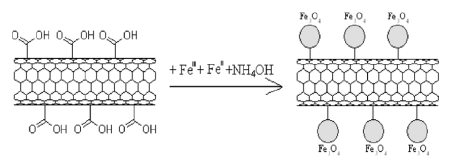
Z.Mitróová, N.Tomaovičová, M.Timko, M.
Koneracká, J. Kováč, J. Jadzyn, I. Vávra, N.Éber, T. Tóth-Katona, P.
Kopčanský: The sensitivity of liquid crystal doped with functionalized
carbon nanotubes to external magnetic fields. New J. Chem. 35,
1260-1264 (2011) [pdf]
A nematic liquid crystal of
low negative anisotropy of the diamagnetic susceptibility has been doped with
spherical Fe3O4 nanoparticles. The surface density of the anchoring energy of liquid crystal
molecules on the surface of the particles has been estimated using the
Burylov-Raikhers theory. The obtained estimates indicate a soft anchoring of
the liquid crystal on the magnetic particles with a preferred parallel
orientation of the magnetic moment of magnetic particles and the director.
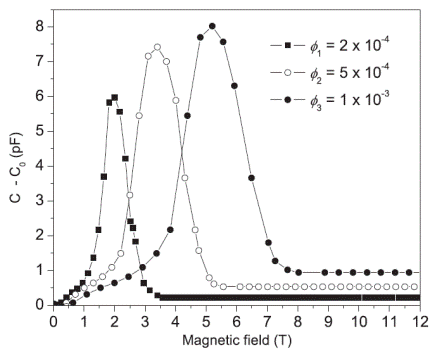
P. Kopčansky, N. Tomaovičová, M. Koneracká, M.
Timko, V. Záviová, N. Éber, K. Fodor-Csorba, T. Tóth-Katona, A. Vajda, J.
Jadzyn, E. Beaugnonand, X. Chaud, The structural instabilities in ferronematic based
on liquid crystal with negative diamagnetic susceptibility anisotropy, J. Magn. Magn. Mater. 322, 3696-3700 (2010) [pdf]
The influence of Fe3O4
nanoparticles on dielectric properties of planar oriented liquid crystal were
studied at the frequency range10-1-106 Hz and in
temperature interval of 292 - 345 K. It was shown that the dielectric spectrum
of doped liquid crystal can be divided into two areas. Parameters obtained from
the dielectric spectrum for frequencies lower than 10 Hz characterize near
electrode processes, and parameters obtained for frequencies more than 10 Hz
characterize the bulk properties of the sample. The relaxation time and
near-electrode area thickness have been estimated. It was experimentally shown
that magnetic nanoparticles change the near-electrode area parameters.
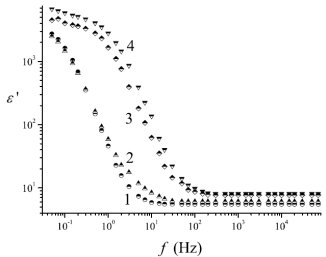
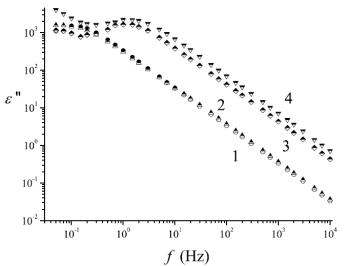
P. Kopcanský, A. Kovalchuk, O. Gornitska, V. Vovk, T.
Kovalchuk, N. Tomasovicová, M. Koneracká, M. Timko, V. Závisová, J. Jadzyn, N.
Éber, I. Studenyak: Dielectric spectroscopy of liquid crystal doped with Fe3O4
nanoparticles. Phys. Procedia 9,
36-40 (2010) [pdf]
|
The
4-(trans-4-n-hexylcyclohexyl)-isothiocyanatobenzene (6CHBT) nematic liquid
crystal was doped with single walled carbon nanotubes (SWNTs) and with
magnetite labeled single walled carbon nanotubes (SWNTs/Fe3O4).
Prepared samples were characterized by infrared spectroscopy, transmission
electron microscopy, optical microscopy and by magnetic measurements.
Electric and magnetic Freedericksz transitions were measured for the pure
liquid crystal, and for the liquid crystal doped with SWNTs, as well as with
SWNTs/Fe3O4 (volume concentration 10-4). The density of anchoring
energy at the nematic - magnetic particle boundary was determined. The value
of the anchoring energy density for SWNTs/Fe3O4 is
lower than for SWNTs. The critical voltage of the Freedericksz transition
depends significantly on the bias magnetic field. |
|
Z. Mitróová, M. Koneracká, N. Tomaovičová, M. Timko, J. Jadzyn, I. Vávra, N. Éber, K. Fodor-Csorba, T. Tóth-Katona,
A. Vajda, P.Kopčanský: Structural transitions in nematic liquid crystals
doped with magnetite functionalized single walled carbon nanotubes.1Phys. Procedia 9,
41-44 (2010) [pdf]
The nematic liquid crystal 6CHBT has been doped with spherical
magnetite nanoparticles of different size (4.2 nm, 11.4 nm,
31.4 nm and 112.7 nm). It has been shown that doping with magnetic particles
smaller than the Shliomis size increases the threshold of the magnetic
Freédericksz transition, in contrast to the case of doping with larger magnetic
particles that decreases the threshold. If the size of the magnetic particles
is comparable with the Shliomis size, both Néel and Brownian rotation of the
magnetic moments are present, however, the Brownian rotation is dominant.

P.Kopčanský, N.Tomaovičová,
M.Koneracká, V.Záviová, M.Timko, L.Tomčo, N.Éber, K.Fodor-Csorba,
T.Tóth-Katona, A.Vajda, J.Jadzyn, E.Beaugnon, X.Chaud: Néel and Brownian
rotations in ferronematics. Phys. Procedia 9,
82-86 (2010) [pdf]
It has been shown that the inclusion of
dodecanethiol functionalized gold nanoparticles (with diameter 35 nm) into the
nematics liquid crystal (6CHBT) enhances its sensitivity to the external
magnetic field, i.e. causes a stronger increase of the electric Freédericksz
threshold voltage with magnetic field.
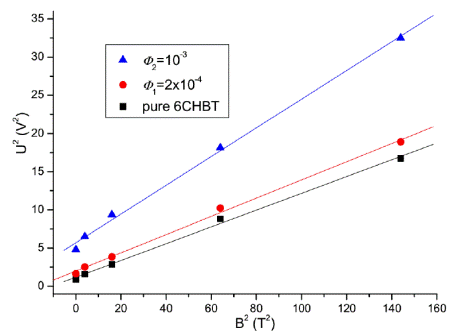
P.Kopčanský, N.Tomaovičová,
M.Koneracká, M.Timko, V.Záviová, N.Éber, K.Fodor-Csorba, T.Tóth-katona,
A.Vajda, J.Jadzyn, E.Beaugnon, X.Chaud: Magnetic Freedericksz transition in
liquid crystal doped with gold nanoparticles. Acta Phys. Pol. A 118, 988-989 (2010) [pdf]
Composite systems of a nematic liquid crystal
with multi-walled carbon nanotubes (MWNTs) and with magnetically labeled
multi-walled carbon nanotubes (MWNTs/Fe3O4) have been
prepared. It has been shown that doping with MWNTs and
with MWNTs/Fe3O4 shifts the threshold
voltage of the electric Freédericksz transition to lower values.
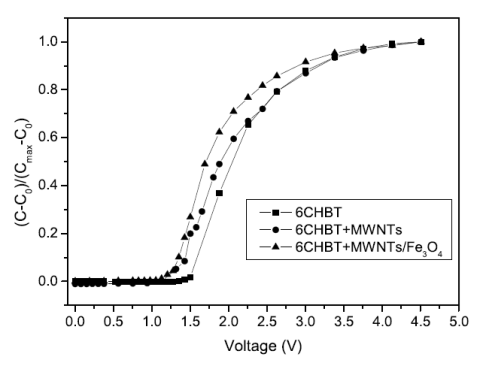
Z. Mitróova, N. Tomaovičová, M. Koneracká, V.
Záviová, M. Timko, J. Kovač, P. Kopčansky, L. Tomčo, N. Éber,
K. Fodor-Csorba, T. Tóth Katona, A. Vajda, J. Jadzyn, E. Beaugnon, X. Chaud:
The structural transitions in a nematics liquid crystal doped with magnetically
labeled carbon nanotubes. Magnetohydrodynamics 45, 353-360 (2009) [pdf]
A nematic liquid crystal has been doped
with differently shaped magnetite nanoparticles (spherical, rod-like, chain-like). Experimental results indicate soft anchoring in
the case of spherical magnetic particles and rigid anchoring in the case of
rod-like and chain-like magnetic particles, with parallel initial orientation
between the magnetic moments of the magnetic particles and the director.
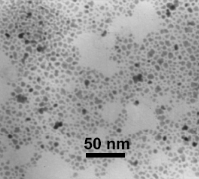

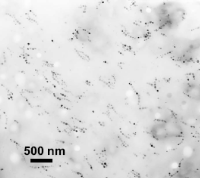
P. Kopčanský, N. Tomaovičová, M. Koneracká,
V. Záviová, M. Timko, A. Darová, A. princová, N. Éber, K. Fodor-Csorba, T.
Tóth-Katona, A. Vajda, J. Jadzyn: Structural
changes in the 6CHBT liquid crystal doped with spherical, rodlike, and
chainlike magnetic particles. Phys. Rev. E 78, 011702/1-5
(2008) [pdf]
Ferronematic droplets have been observed in mixtures of the nematic
6CHBT with phenyl isocyanate and fine magnetic particles. The phase diagram of
the system shows that the transition from the isotropic to the nematic phase
occurs via a two-phase droplet state. The type of anchoring of the nematic
molecules on the surface of the magnetic particles in the droplets has been
estimated based on magneto-dielectric measurements.
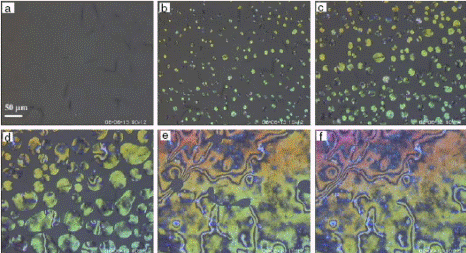
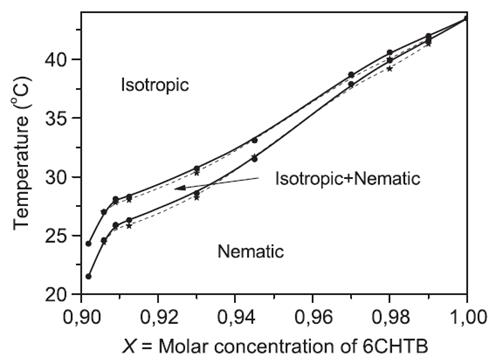
N.
Tomaoviová, P. Kopčanský, M. Koneracká, L. Tomčo, V. Záviová, M.
Timko, N. Éber, K. Fodor-Csorba, T. Tóth-Katona, A. Vajda and J. Jadzyn: The
structural transitions in 6CHBT-based ferronematic droplets. J. Phys.: Condens.
Matter 20, 204123/1-5 (2008) [pdf]
HAB (4,4-di-n-heptylazoxybenzene) based ferronematics have
been prepared by addition of spherical magnetic nanoparticles and investigated by DSC. Magneto-dielectric measurements indicate a soft anchoring with the
magnetic moment of magnetic particles parallel with
the director.
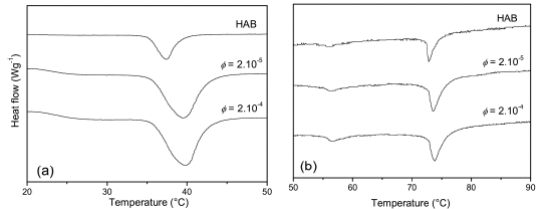
N. Tomaovičová, M. Koneracká, P. Kopčansky, M.
Timko, V. Záviová, A. Vajda, K. Fodor-Csorba, N. Éber, T. Tóth-Katona, J.
Jadzyn: The Anchoring Energy of Liquid Crystal Molecules to Magnetic Particles
in HAB-Based Ferronematics. Acta
Physica Polonica A, 113, 591-594 (2008) Acta Phys. Pol. A 113, 591-594 (2008) [pdf]
